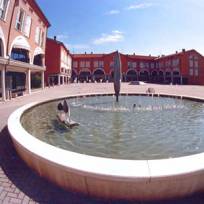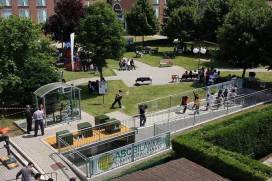In the expression ‘a museum beyond the museum’, The Museum of Scales and Balances recognizes its true purpose as an institution situated in a land covered with traces and signs linked to an interesting productive technology which gave rise to various weighing instruments.
- The first home of the museum, founded in 1989, was located in Viale di Vittorio, in one of the old branches of the Scale-Makers’ Cooperative, which today is one of most important manufacturers of scales on a global level. In 1997, the museum moved to its current location, the former distillery of the Cooperative Winery of Campogalliano. The building, while having to meet the needs of functionality, shows great respect for traditional rural architecture.
- With the installation of a steelyard bridge scale manufactured by the Crotti company, recovered from the old Modena cattle market, in a public garden in the Museum of Scales and Balances, there was a desire to further underline the ties between the local area and the Museum. It was built by the Crotti company in 1945, restored by ABC Bilance and later the Cooperativa Bilanciai installed a load cell which made these scales electronic. This steelyard bridge scale itself has undergone a series of interventions involving the majority of the territory’s industrial and artisan sectors. The Museum of Scales and Balances intended to restore the instrument for educational purposes, identifying each part with a different colour, giving it the name ‘Rainbow of Levers’. It is an instrument which allows great weights to be measured, up to 12,000 kg, therefore during school tours, the whole class can be weighed.
- The journey from the museum to the medieval heart of the city, Piazza Castello (Oratorio San Rocco), crosses Piazza Vittorio Emanuele II, the historic square of the city centre, completely restored and returned to the residents of Campogalliano in June, 2004. The project aimed to give wider visibility to the existing architecture, dedicating particular attention to the traffic flow which now passes much more slowly. Special attention has been paid to the symbolism which adorns the roundabout traffic barrier: equal-arm beam scales have been inserted in the granite, drawn with concrete mixed with pink marble powder.
- Walking along the streets of the town, it is possible to come across instruments for weighing in display cabinets and public buildings, as well as in the surrounding area where there are old buildings which have housed some of the most important manufacturers of scales of the last century.
- Crossing the main square you come to Piazza Castello, around which the town was built. On the east side of Piazza Castello is the Oratorio di San Rocco, built in 1600, which after having been sold in the 1900s and deconsecrated, is now the property of the municipality and is used for temporary displays and exhibitions.
- Also of note is the public tower of Campogalliano, which dates presumably to the 16th century, where the first town clock was to be placed. This clock was then replaced by another in the mid 18th century, constructed by Lodovico Riva, highly respected at the time (he had constructed other clock mechanisms for the towers of squares in Modena and Ferrara). The clock mechanism is now exhibited in the museum, while an electric mechanism was installed in the tower in the early 1980s.











